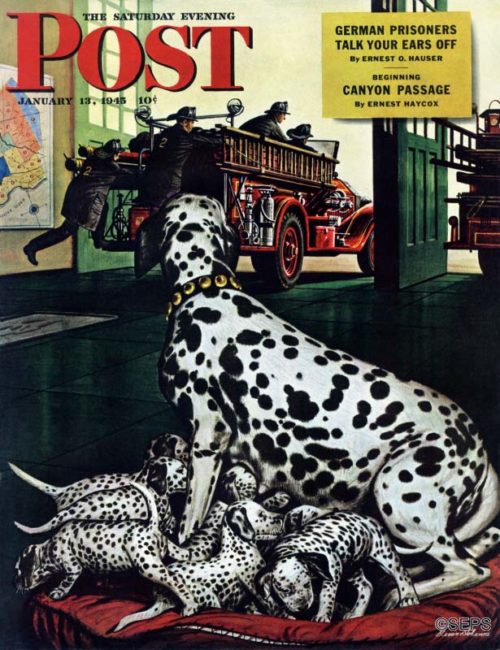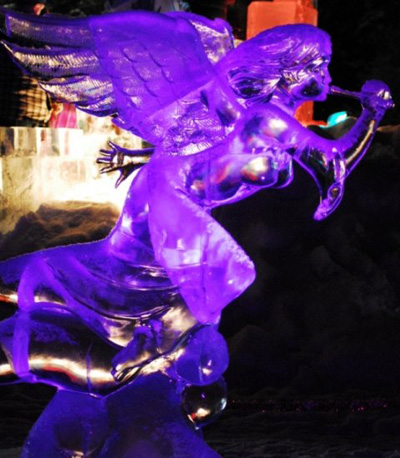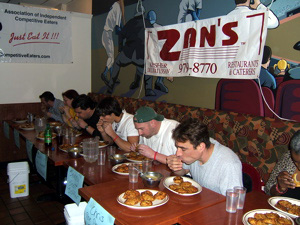Post Travels: North Pole, Alaska
One would expect the North Pole is a busy place this time of year. But truth be told, it’s Christmas every day of the year in North Pole, Alaska. Less than a 20 minute drive from Fairbanks, the city is known for its holiday spirit. Street lights look like giant candy canes and assorted buildings sport Christmas colors and patterns. The Santa Claus House boasts a nearly 50-foot Santa Claus statue and walls covered with letters to Santa. As this video shows, even streets have names like Santa Claus Lane and St. Nicholas Drive.
See more Post Travels.
Cover Gallery: Dogs with Jobs

Paul Bransom
February 16, 1907
Paul Bransom illustrated numerous animal covers for the Post. A longtime resident of New York City, Bransom spent summers at Canada Lake in the Adirondacks, where he found much of his inspiration.

Oliver Kemp
October 16, 1909
Peary made numerous attempts to reach the North Pole, many with the assistance of sled dogs. Whether he actually reached the North Pole is widely debated.

Charles Bull
November 23, 1918
During World War I, dogs were used to locate wounded soldiers on the battlefield and bring back help. Approximately 10,000 dogs were in use by the end of the war.

J. C. Leyendecker
July 29, 1922
In the mid-1800s, the Standard Poodle became a popular circus performer because of its intelligence and stamina.

Norman Rockwell
August 18, 1928
The dog has long served in the role of family guardian. Norman Rockwell had earlier portrayed dogs with “hobos” who were down on their luck, but this was the first illustration of the culprit getting a nip in the seat!

J. F. Kernan
November 3, 1928
An athlete and outdoorsman, artist Joseph Francis Kernan was known as the “poor man’s Norman Rockwell.” But Kernan was a superb illustrator in his own right. His art featured, as he described it, “the human side of outdoor sports, hunting, fishing, and dogs.”

Norman Rockwell
March 28, 1931
A new approach to painting developed by Jay Hambridge – “dynamic symmetry” – was emerging, and Rockwell’s artist friends told him that he had better begin using it. This painting was his first attempt at the technique. Rockwell deemed the idea a failure, and gave the painting to a cousin who lived in Philadelphia. He vowed never to wander from the time-tested formulas that had worked so well in the past.

Maurice Bower
February 29, 1936
Maurice Bower primarily painted horses and sports scenes for the Post; this was his only cover featuring dogs.

Lonie Bee
November 18, 1939
All of Lonie Bee’s cover illustrations were about the lighter side of sports – in this illustration, the dog seems as sad as the cheerleaders!

Paul Bransom
March 29, 1941
In the 1930s, dog racing was illegal, and considered by many to be unsavory because of its affiliation with mobsters. When Bransom painted this cover in 1941, only four states had legalized greyhound racing: Florida, Oregon, Massachusetts, and Arizona.

Stevan Dohanos
January 13, 1945
After painting 123 covers for the Post, Stevan Dohanos became chairman of the National Stamp Advisory Committee where he oversaw the art design for over 300 stamps. His depictions include presidential portraits, NATO commemorative stamps from 1959, and the 1967 John F. Kennedy commemorative stamp.
7 Festivals for Winter Fun!
Holiday celebrations abound as we approach a New Year. Cultures around the world are engaging in convivial occasions. While customs vary, they all share one simple thing in common—fun. From the timeless appeal of holiday decorations to the vibrant colors of a Chinese New Year Parade, the Post celebrates some of the country’s most entertaining winter festivals.
First Night Boston (Boston)
While there are countless venues that celebrate New Year’s Eve in style, the venues are not always family-friendly. In Boston, one tradition keeps New Year’s entertaining and enjoyable, sans the alcohol-induced shenanigans.
First Night Boston was started in 1976 by a group of local artists and citizens looking to create an alternative to customary New Year’s activities. Three decades later, the event is going strong. Run by the nonprofit First Night, Inc., the event is funded through the sale of $18-buttons that serve as a badge of honor to those who support the Boston arts community and act as an admission ticket to numerous events. In 2009, patrons of First Night witnessed ethnic dancing, live music (from saxophone quartets to African drummers), visual art exhibits, puppet shows, and a circus. The goal is to foster the creativity that has made Boston one of the country’s most interesting cities.
When: December 31-January 1, 2009
Where: Boston, MA
Website: First Night Boston
North Pole Christmas in Ice (Alaska)

The city of North Pole, Alaska, is home to one of the coolest Christmas festivals in America (pun intended). During the city’s “Christmas in Ice” event, the world’s greatest ice sculptors create a frozen wonderland perfectly suited to a town called North Pole.
Putting on the event is no easy task. Ice sculpture in and of itself is a challenge—arguably the most fragile art form in the world. And while the North Pole’s location (near Fairbanks in mainland Alaska) makes it ideal for the frosty art form, harsh winter conditions can present extreme obstacles. Cold snaps where the temperature dips below -40° F for days on end are not uncommon in the Alaska Interior. Even the simple task of getting from point A to point B can be a hard-won feat.
The difficulty offers clues as to why we host festivals in the first place. No matter how harsh the conditions are or how tough the daily grind, we love festivals because they quite simply cheer us up. Ice is an inescapable fact of life in North Pole. Why not celebrate it? The Christmas in Ice event deserves special respect because amid some of the harshest conditions on Earth, the festival brings a smile to the faces of those who know the meaning of the word survival.
The end result? Multifaceted works of ice art. More than a thing of beauty, however, ice becomes an entertaining mode of transportation on ice slides, which range from kid-sized to 100 feet long, and even more fun awaits at the entrance of this year’s ice maze.
When: December 5-January 3, 2009
Where: North Pole, Alaska
Website: Christmas in Ice
National Potato Latke Eating Contest (TBA, NY)

Chanukah is a holiday with many great traditions. It is known as “The Festival of Lights” because of the Hanukiah, a special type of Menorah that is, perhaps more than anything, emblematic of the Jewish faith as a whole. Dreidel, the ancient game that combines the physics of a spinning top with the luck of gambling, makes its annual appearance this time of year. And, of course, the tradition of exchanging gifts occurs on each of the holiday’s eight nights. The tastiest Chanukah tradition, however, is the latke. This delicacy is comprised of potatoes, onions, and a secret ingredient known as schmaltz and is a special treat that Jewish people look forward to all year. During the National Potato Latke Eating Competition, contestants from all over the world indulge themselves in a feast of epic proportions.
Latkes are served by the hundreds during the fierce gastronomical battle, and contestants mean business—last year’s winner, “Furious” Pete Czerwinski, set a world record by eating 46 latkes (equal to about seven pounds of potatoes) in eight minutes. Can he defend his crown? “Furious” Pete will face off against such legendary food warriors as Elizabeth “Rubber-Gut” Canady and Mark “The Human Vacuum” Lyle, both of whom have participated in years past. Of course, up-and-comers hungry for a piece of golden-brown fried potato glory this year could take home the crown as well. Although this event has been marred by controversy (Phil “Clowny Chompers” Teglia was caught stuffing latkes in his pocket in 2007, an illegal performance-enhancing technique), the atmosphere should be sizzling in 2009. For more information, visit Zan’s Deli or The Association of Independent Competitive Eaters
When: TBD
Where: New York
Website: Zan’s Deli
Day of the Dead (Oaxaca, Mexico)

The Day of the Dead (Dia de los Muertos) in its current form is the product of a cultural clash. Ancient Aztecs viewed life as a dream; only in death did one become awake. This festival honored what they viewed as the completion of the life cycle. When the Spanish conquistadors saw the ancient practice, they viewed the practice as sacrilegious paganism. However, try as they might, the Spaniards were not able to stop the annual event. Eventually, the celebration was moved to November 1 (All Saints’ Day) and November 2 (All Souls’ Day), in an effort to convert the indigenous people to Catholicism. It is still celebrated on these dates today, and has become an exotic blend of ancient rituals and Christian theology.
One of the best places to experience Dia de los Muertos is Oaxaca, Mexico. The highlight of the event occurs after nightfall, when city streets are crowded with people celebrating the deceased. Many don wooden skulls called calacas—a throwback to Aztec tradition, and almost all wear unique costumes. The sound of trumpets, the movement of dancing, the sight of vibrant costume colors, and the emotion of merrymaking signal a night of celebration. During the day, shop windows showcase skeleton figurines called calaveras, which depict people of all professions fulfilling the same activities as when they were alive. Street vendors sell skull-shaped candy; flowers from the countryside; special bread known as pan de yema; and homemade altar candles. TCountryside traditions are equally interesting. Families visit loved ones’ graves, bringing food and music for the enjoyment of living and dead alike, and each small town touts unique traditions. Whether in the bustling city or the quaint countryside, visitors to Oaxaca will enjoy a cultural experience unlike any other. For more information, visit the Oaxaca Secretary of Tourism website.
When: November 1 & 2, 2009
Where: Oaxaca, Mexico
Website: Day of the Dead
Natchitoches Christmas Festival of Lights (Louisiana)

Palm trees adorned with Christmas lights in Hawaii, decorative boat parades in Florida, Christmas caroling in New England—American holiday celebrations are as diverse as the “melting-pot” itself.
Consider Natchitoches, Louisiana, where the Christmas spirit comes alive with a bayou twist. This year marks the 83rd year that Natchitoches (pronounced nak-i-tosh) has put on its annual Christmas bash—the longest-running Christmas festival in Louisiana. Visitors enjoy holidays with some southern hospitality. The whole event began as a byproduct of the American innovation that shaped the 20th century. In 1926 Max Burgdof, the man who installed the first electric generators in Natchitoches, decided that stringing up Christmas lights along Front Street would make an excellent Christmas gift to town citizens. Ever since, people from Natchitoches and surrounding communities have come to witness the lights switch on. Beginning in the ’30s, visitors also came to enjoy the sight of fireworks and their reflection on Cane River Lake. Nearby Cane River Creole National Historic Park complements the festivities—adding to the parades, historic tours, lighted barges, pageants, and contests—with special events of its own. Natchitoches is right in the heart of Cajun country, and as one would expect first-class food abounds. The town even has its own contribution to international cuisine—the world renowned Natchitoches Meat Pie is made especially for this all-American festival.
When: November 21-January 6, 2009
Where: Louisiana
Website: Natchitoches Christmas Festival of Lights
Chinese New Year (San Francisco, California)

Traditionally celebrated with colorful parades, unforgettable foods, entertaining carnivals, and more, the Chinese New Year is a visually stunning, tastebud-pleasing occasion. The holiday is based on a lunar calendar, so the date varies from year to year. It falls on February 14 in 2010, and cities across the world will bring in the Year of the Tiger in their own unique way. Perhaps the best place to experience this cultural festival on a grand scale, however, is San Francisco.
Because the city has such a large Chinese population (it boasts the largest Chinatown in the U.S., about one-fifth of the population is of Chinese descent), the Chinese New Year is unquestionably a big deal. In fact, this festival is considered the largest celebration of Asian culture outside of Asia and has been a San Francisco tradition since 1860. The celebration is as much a part of the city’s heritage as crab cakes.
The festival kicks off with a flower market fair where vendors sell food, fruits, and, of course, flowers. Many Chinese households keep live blooming plants to symbolize the new growth and regeneration of the New Year. While festivities include a 10k run, Miss Chinatown Pageant, and community fair, the highlight of the celebration is the parade. Chinese acrobats, lion dancers, stilt walkers, and an assortment of floats explode onto the streets, showcasing the finest entertainment with authentic Asian flare. The procession ends with the 200-foot-long “Golden Dragon” carried by 100 members of the White Crane Martial Arts group and accompanied with over 600,000 fireworks.
When: February 6-28
Where: San Francisco, California
Website: Chinese New Year Parade
Rock City Enchanted Garden of Lights (Georgia)

Located about six miles from downtown Chattanooga, Tennessee, Georgia’s Lookout Mountain is always a visual treat, regardless of the season. Features like Ruby Falls (the tallest underground waterfall in the U.S.), Rock City Gardens (a 4,100-foot-trail showcasing the best of the mountain scenery), and Needle’s Eye (one of many stunning rock formations) make Rock City an American landmark.
And the destination becomes truly special during Yule. In 2009, the city celebrates the 15th anniversary of the “Rock City Enchanted Garden of Lights”—a month-and-a-half-long extravaganza where the natural beauty of the mountain is complemented with a one-of-a-kind light display. More than 1 million Christmas lights illuminate the famed Rock City trail every night except Christmas Eve during this award-winning event.
When: November 20-January 2, 2009
Where: Rock City, Georgia
Website: Rock City Enchanted Garden of Lights